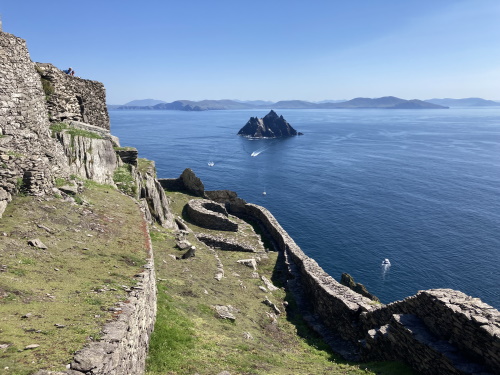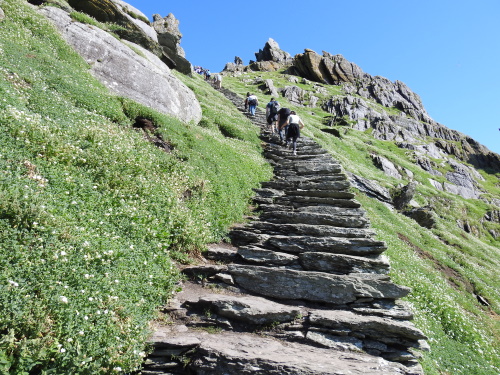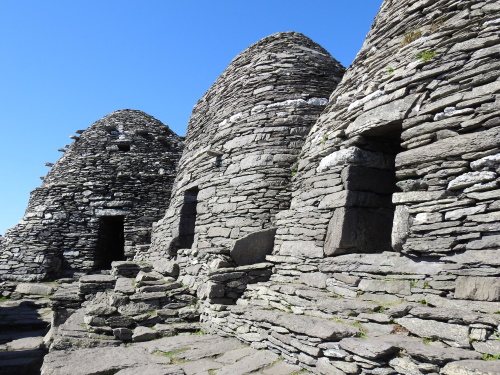Blog WHS Visits
Skellig Michael 2022
In my experience, even after having covered the WHS of a continent well, there are always those annoying little islands left at the fringes to ‘tick’. In Europe for example, I am missing St. Kilda, the Vega Islands, and even Risco Caido on Gran Canaria! Skellig Michael has also been a nagging thorn in my side for years, after missing out due to bad weather on my first try in 2019. On August 12, 2022, my second attempt was succesful. This WHS has been closed a lot over the past 2.5 years, so I think it’s worthwhile to share some up-to-date visitor information in addition to my personal experience.
How and when to visit
There are at least 3 ways to get a look at the island:
- From a distance: from the Kerry Cliffs (4 EUR entrance) or the viewpoint just outside of St. Finian’s Bay (free) you can see it, although it lies still some 10km away. I did this in 2019, and with the help of my superzoom lens and a little post-processing, I managed to take this shot of Skellig Michael. I did not count this as a ‘visit’ as you do not feel its remoteness and surrounding rocky waters. The stairways and structures on the island also aren’t visible to the naked eye.
- Boat tour around the island: there are dozens of daily departures if the sea is not too rough. They promise to get you “within touching distance” of the island and stay there for about 45 minutes. The boat ride up there will give you the iconic views of the pyramidal rock that are part of its OUV. You can also “see several features not visible from the island paths, such as the disused lighthouse, and other monastic stairways”. Views of the Monastery though are limited and the WHS core zone is land only. In 2022, these tours are priced at 45 EUR + 5 EUR booking fee.
- Landing tour: limited to 15 boats a day, weather permitting. A tour now costs between 120 and 140 EUR. You’ll set foot on land, walk the same stairways as the monks did, and have up-close views of their constructions. For safety reasons (so people do not rush on the stairs), all stays are at least 2.5 hours long. It’s the best possible visit, but you could even trump this by receiving permission to visit the Hermitage as well on the far side of the island.
General things to consider before you go:
-
If you’re in doubt about whether you could do it (height or sea-wise), there’s an excellent safety video that shows the landing tour in great detail.
-
Booking nowadays is mostly done online. The websites will show a calendar of availability. Cancellations are more common at the start and end of the tourist season when the weather is less predictable. The 2022 landing season runs from May 14 – September 30.
-
The success rate of a landing seems to be a well-guarded secret, although I’ve seen mentioned that the boats go out “every 5 out of 7 days”. Based on the most recent management plan, in 2019, 15,616 people set foot on the island. At a daily visitor rate of 160-180 and let's say a 4-month season, that would be a 54%-61% success rate on a given day...
-
Rockfall nowadays is the site’s biggest threat and the reason for its closure from June 13 to July 2nd this year.
My visit in 2022
I booked just 3 weeks before, as I surprisingly found open spots for landing tours available in August. Friday August 12 was forecasted as sunny with winds between 5 and 7 km/h in the morning (I believe anything below 20 km/h is low). I was on the 8.30 departure of the Jerdemar, booked via Skellig Michael Cruises. The boat, just large enough to fit the 12 passengers, has an overhead covering which was a blessing on this sunny day. The boat ride was uneventful and nobody got nauseous or wet.
The first bit of excitement came when we arrived at Little Skellig: this island is just littered with gannets. We observed them for a while from the boat, and we discovered a seal at its coast as well. The bigger Skellig next door, Skellig Michael, looks green in comparison. We started our visit there with a slow circumnavigation of the island. The skipper pointed out the various boat landings and stairwells that are not used anymore. Also, the old and current lighthouses are visible. And there was another seal waiting for us.
We disembarked at 10.20, so almost 2 hours after we left Portmagee. The landings of the 180 daily visitors are staggered, so the small island doesn’t get overcrowded. We had to share our slot with 2 other boats. One first walks on a flat trail along the rock wall, this includes an area with new wooden coverings after the rockfall incident earlier this year. You’ll also pass the visitor's toilet, a new addition to the site. There is more construction going on: the authorities are upgrading the path to the lighthouse, which would offer alternative things to see for the visitor. Now we all had to go up to the monastery! At the bottom of the stairs, we had to wait first for a guide to give us a safety talk.
The stairs don’t require big steps and are wide enough to let people pass. There are several places as well to step aside and catch your breath. It takes people generally 25 minutes to get to the top, and you see people of all ages and sizes succeeding. At the end of the day, I did not feel my legs at all, so it isn’t very strenuous. My health app reported that I covered 3km and 39 ‘floors’ (= 39 * 16 steps).
The climb is worth it anyhow, as it gives you a feel of the monks’ work to ‘tame’ this island. The best part undoubtedly is the monastery area, where you can see the beehive huts, the vegetable gardens, the cemetery, and the cisterns (there’s no water source on the island). This is a small, enclosed area and with 36 tourists milling around it was hard to get photos without people in them. One of the guides that live on the island gave a talk about the history of the monastery and what the purpose of the buildings was.
By 12.15 I walked down again, my boat was set to leave at 1 p.m. I did take my time to take photos of nesting birds and local flora. I can’t see the island getting any natural recognition though, too much has been altered over the ages (not only by the monks but also due to the construction of the two lighthouses and a helipad) and I did not find the scenery as pretty as similar sites in Iceland or Newfoundland. The return boat journey took about an hour, so it was a 5.5-hour tour in all. The outstanding part of the day for me was seeing the fairly intact dry stone monastic constructions, considering how old they are and what an effort it must have been to create them.
Els - 14 August 2022
Comments
Els Slots 16 August 2022
Thanks for the link, Liam! Interesting to read.
"he thinks the Star Wars hype around the island has seen its peak"
Liam 15 August 2022
Well done! There was a pretty good article on the experience of working on Skellig Michael this weekend on the BBC too: 'I like the solitude and peace of the island'
https://www.bbc.co.uk/news/world-europe-62280677
Jay T 14 August 2022
So glad it worked out for you the second time! Skellig Michael looks amazing.


